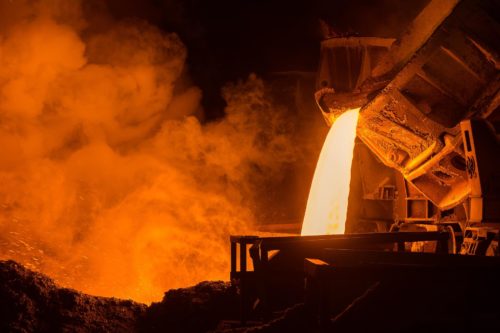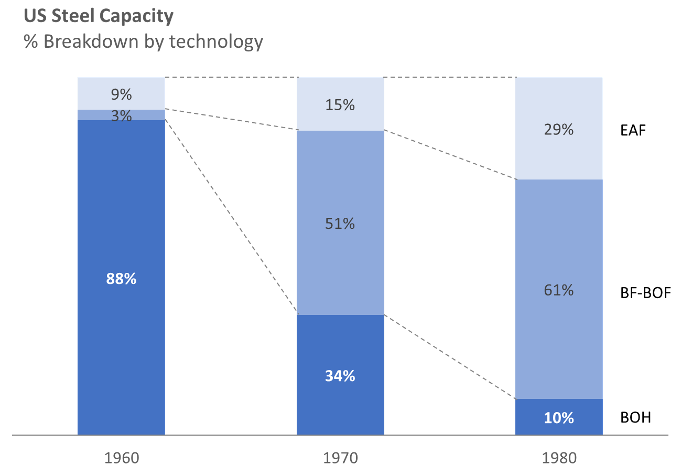very hot steel pouring in steel plant

Green Steel: A Multi-Billion Dollar Opportunity
In the Zurich Diamond League 800-meter finale in 2019, Donavan Brazier was in 7th place halfway through the race, 15 meters behind the leaders of the race. In fact, as the cameras were focusing on the leader of the race, Nijel Amos of Botswana, Brazier was literally not even on the screen. All the expert commentators assumed his race was forfeit. But through a miraculous turn-around, he sprinted past all his opponents and won the race, bagging a new personal record time of 1:42:70—making him the second-fastest American in history.
Over the last 30 years, reduction of greenhouse gas emissions has been on the political agenda, with increasing emphasis. Consistently, the primary focus and early progress has been within the electricity and personal mobility spaces, with other sectors referred to as “hard-to-abate.”
But while no major technology shift has been introduced in the steel industry, the energy required to make a ton of crude steel has dropped by 40 percent in this 30-year period. This can be compared to the CO2 intensity of global power systems dropping by 33 percent over the same time. This is a compound effect from continuous energy efficiency improvements that pay for themselves and increasing access to scrap steel that enables more recycled material flows.
The challenge is that while we can anticipate continued progress, this trend will never get us to net zero emissions. New technology is fundamentally required—and fast.
On August 31 2020, Swedish steel maker SSAB, in a joint venture with iron ore producer LKAB and utility Vattenfall, opened a breakthrough pilot plant for hydrogen-based primary steel in Luleå, Sweden. The plan is to establish a demonstration plant at scale in 2026, a pace of change that globally needs to increase 100-fold to achieve a net-zero emission outcome by 2050.
The Next 30 Years Will Be Different
The relentless cost reductions of renewable energy generation are reaching a critical inflection point, where new wind and solar assets are competitive even with existing coal and natural gas plants. This presents structural challenges for the electric utility industry. But it is also shifting the global energy market landscape away from fossil fuel reserves being a strategic resource to favoring access to favorable conditions for renewable electricity generation. This will open up space for new industrial footprints and has the potential to fundamentally shift geopolitical balances.
One of the reasons decarbonization of steel is “hard” is that CO2-free primary steelmaking is perceived to be a premium-cost product. This suggests that achieving a net-zero industry requires perpetual subsidies compared to the current policy and market environment. However, our cost modeling shows that this technology may already be cost-competitive. With power prices at $25 per megawatt-hour, which is achieved in many locations around the world today, and hydrogen electrolyzer costs of $450 per kilowatt, which will be achieved by the end of this year, zero-carbon primary steel without coking coal can reach a fully loaded production cost of $400/ton. This is competitive with many existing steel mills today.
It is important to note that the cash cost of these steel assets would be significantly lower, given the high capex/low opex structure, making them quite competitive in the market. In addition, steelmaking fundamentally is a business that brings together two bulky commodities—coking coal and iron ore. As coking coal is taken out of the equation it makes perfect sense to explore locations closer to iron ore reserves. This is why countries like Australia are looking into the opportunity of establishing themselves as a global steel export superpower, similar to what China achieved in the early 2000s.
The opportunity for CO2-free steel is riding on multiple compound cost-reduction pathways: renewable energy, where solar and wind costs are still dropping fast year-on-year, hydrogen electrolyzers, still in early stages of cost compression, and hydrogen direct reduction, a quite nascent technology. Since the energy supply components are already performing at the levels required for competitiveness, what is really holding back the opportunity is the pace at which this new steelmaking technology can be commercially rolled out and scaled into the market.
Solving Multiple Problems with Green Steel
US General Dwight D. Eisenhower said: “Whenever I run into a problem I can’t solve, I always make it bigger.” In the context of steel sector decarbonization, expanding the problem statement beyond how to decarbonize the current asset base is surfacing some strong drivers that can facilitate and accelerate the transition.
It is broadly accepted that a regional steel industry is an engine of downstream innovation and economic growth through the engineering, manufacturing, and production sectors. According to the World Steel Institute, each job created in the steel industry generates additional 8 indirect jobs. In addition, several regions and countries, such as Chile, are currently setting ambitious targets for their role in the “hydrogen economy,” which ultimately allows them to monetize their renewable resources beyond domestic electricity demand.
In this context, many markets are suffering “chicken or egg” challenges. Potential users of energy are hesitating to fuel shift to hydrogen because supply chains are not reliable and potential suppliers of energy are hesitating to build out capacity because there is not enough demand.
Establishing a large-scale steelmaking cluster would leapfrog the market into critical scale with at least 1 GW equivalent of electrolyzer capacity, likely closer to 10GW. Additional market demand can grow gradually from that starting point, benefiting from both infrastructure and economies of scale.
Further adjacent benefits include the opportunity to use hydrogen at scale as a flexibility and storage asset to enable higher penetration of renewables in electric grids. And in the current environment of COVID-induced recession, the value of direct and indirect job creation from downstream industries cannot be understated.
Few of these reasons are sufficient motivation on their own for the magnitude of investment required to deploy large-scale industrial assets in a new context. However, as they align objectives and outcomes for multiple stakeholders the collective benefit could tip the scale for bold projects.
A Rapid Transition Is Impossible—until It’s Not
Another reason transition of the steel industry is “hard” is because the long lifetime of steel mills. But this was arguably the case also in the 1960s, when the industry embarked on an incredibly fast transition from predominantly operating open hearth furnaces (BOH) to largely making steel in basic oxygen furnaces (BOF) and electric arc furnaces (EAF).
Steel-making with electric arc was developed already in the 19th century but the technology’s market share is generally constrained by the access to scrap as a raw material. But in 1948 a Swiss engineer called Robert Durrer developed the “Linz-Donawitz” process, broadly known as basic oxygen furnaces (BOF). The first commercial pilot plant were completed in 1952, and while this innovative way of making steel looked promising, it would arguably take many decades to achieve significant structural change in the industry.
But three things happened simultaneously that led to an unprecedented replacement of assets worth billions of dollars. First, the new technology commercialized by Durrer turned out to be cost-competitive. Second, it helped solve larger societal problems, namely the health and safety issues associated with operating steel smelters in the open air. Third, industrial oxygen became available at reasonable cost and large scale. The resulting transition shifted the share of BOH furnaces in US steel capacity from 90 percent to 10 percent in 20 years and left behind droves of “stranded assets.”

Mobilizing the Next 10 GW of Hydrogen-Based Steel
While a critical step in the technology development process, the HYBRIT project will not in itself change the steel industry. SSAB has a global market share of a fraction of a percent. For the industry as a whole to pursue a climate-aligned pathway towards a 1.5°C outcome, this asset needs to be replicated thousand-fold.
With the lead time involved in project development at this scale, focused and serious efforts need to get going within the next few years to be lined up for actual build-out in a timely manner. To facilitate this, in the next 2–3 months RMI is hosting a number of roundtables with local stakeholders in regions where the conditions on a high level are favorable: South Africa, Australia, Latin America and the Middle East / North Africa. Insights from this effort will be published in a more thorough perspective later in the fall, incorporating specific considerations driven by local contexts.
There is still a long way to go to transform the global steel industry in line with a 1.5°C future. But there are fewer barriers to deploying hydrogen-based direct reduction steel than many have thought. Steel has a better future in front of it, and one that has tremendous implications for hydrogen as well. However, we need to move quickly and start preparing for the next tranche of multi-billion-dollar investments while the ink is still drying on the drawings of the pilot plant.
